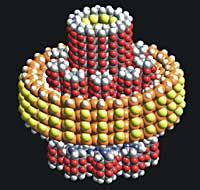The revolution of the nanomotors. This time yes?
2005/03/01 Elhuyar Zientzia Iturria: Elhuyar aldizkaria
The nanorrobots that advance through the blood vessel destroying invading molecules are still sci-fi. However, it seems less and less to have devices moved with nanomotors. The advancement comes from the hand of chemistry.
So far, most groups working in nanotechnology have used proteins such as atp-synthase to get the energy needed to move devices. However, proteins deteriorate easily, so they have not come very far from that path.

Now, researchers at the University of Pennsylvania (USA) have tried a new opportunity. They have used platinum catalytic activity to move tiny gold shafts. An end of the platinum covered axis, in an aqueous solution, converts hydrogen peroxide into oxygen and water. Then a zone rich in oxygen is created that reduces the surface tension between the end of the axis and water.
Consequently, the axis moves in that direction and generates more oxygen in the path. The only problem is that it moves as if it were drunk, in zigzag.
To solve this, nickel traces have been attached to the shaft. Thus, by magnetizing nickel and applying a magnetic field, the axis is oriented perpendicularly. This allows researchers to drive the shaft with a simple magnet. Using the same mechanism, they have also managed to spin a nanogear, covering on one side the gear teeth with platinum.




